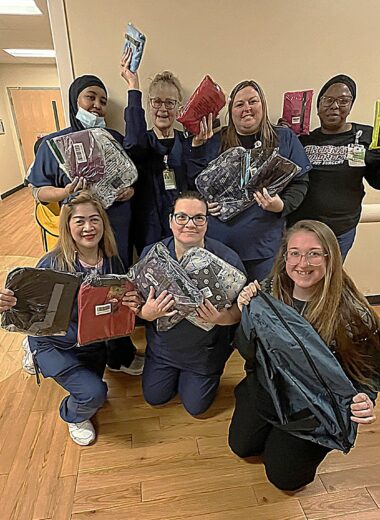
Healthcare facilities promise a safe environment for staff, patients, and visitors; environmental services (EVS) helps healthcare organizations live up to that commitment.
What Is Environmental Services (EVS) in Healthcare?
Sometimes referred to as housekeeping or janitorial services, environmental services is a term used exclusively in healthcare to describe the process highly trained support service staff conduct to clean and disinfect medical equipment, patient rooms and other common areas within healthcare facilities. Environmental services prevent infections from spreading and also help reduce HAIs.
According to the CDC, HAIs cause sickness, death and add billions of dollars to healthcare costs each year, and on any given day, about one in 31 hospital patients has at least one HAI.
EVS professionals are essential to contributing to patient safety, infection prevention, and operational excellence. Specialized training, advanced tools, and evidence-based practices ensure that healthcare facilities meet the highest standards of cleanliness and infection control.
Their work creates safe, clean environments where patients can heal, clinical teams can focus on patient care, and families can trust that their loved ones are in a clean and safe space.

What Does an EVS Worker Do?
As a visible and vital part of the patient experience, EVS professionals ensure that clinical staff can focus fully on patient care without concerns about hygiene, contamination, or safety. By adhering to the rigorous safety and regulatory standards set by The Joint Commission (TJC) and the Centers for Disease Control and Prevention (CDC), and others, EVS teams build trust and provide the safety that patients and families rely on during critical times. Every disinfected surface and sanitized room reflect their dedication to fostering spaces that promote healing.
Critical tasks of EVS professionals include:
- Cleaning and Disinfecting Patient Rooms and Common Areas
Ensuring high-touch surfaces, shared spaces, and equipment remain sanitized throughout the day to minimize the risk of infection. - Proper Waste Management and Disposal
Safely handling and disposing of waste, including biohazardous materials, to prevent contamination and maintain a safe environment. - Maintaining Cleanliness of Medical Equipment and Supplies
Preserving the sterility and usability of critical healthcare tools to support clinical teams and safeguard patient care.
Why is it Important for Hospitals Maintain a Clean and Safe Environment?
Prevention of Healthcare-Associated Infections (HAIs) is crucial. EVS professions actively eliminate harmful pathogens and reduce the risk of HAIs. Their work ensures patient rooms, shared spaces, and high-touch areas remain clean and safe—creating spaces where healing can happen effectively and patients feel secure and reassured.
While a clean and safe healthcare environment is essential for infection prevention, it also plays a critical role in fostering trust and shaping perception. Patients and their families often judge the quality of care by what they see and experience the moment they enter a healthcare facility.
The perception of cleanliness is just as important as the reality. A visibly clean and well-maintained environment reduces patient anxiety and builds trust in their care. This attention to detail shapes the experiences of both patients and their families can influence their likelihood to recommend the healthcare facility, regardless of the quality of clinical care.
A spotless, organized space provides reassurance that their safety and well-being are a top priority. EVS professionals ensure every room, hallway, and surface is not only clean but feels clean, instilling confidence and reinforcing the facility’s commitment to care and safety.
What Are the Benefits of Environmental Services in Healthcare?
The expertise and dedication of EVS professionals are foundational to the success of healthcare facilities, driving improvements in safety, patient outcomes, and overall satisfaction:
- Improved Patient Outcomes and Safety:
A meticulously cleaned and disinfected environment safeguards patients from preventable risks, directly supporting faster recovery and better health outcomes. - Reduced Risk of HAIs:
By eliminating harmful pathogens at their source, EVS professionals play a critical role in stopping the spread of infections, protecting patients, staff, and visitors alike. - Enhanced Patient Experience and Trust:
Through their consistent presence and attention to detail, EVS workers not only ensure cleanliness but also instill confidence in the facility’s commitment to safety and care, positively influencing patient perceptions and recommendations.
Professional Development is Key to the Success of EVS Team Members
Keeping up with emerging infection prevention techniques, advanced technologies, and safety protocols is essential to patient safety and the healthcare experience. Investing in EVS team members reflects a commitment to their growth and the success of the facilities they support.
Key aspects of professional development for EVS professionals include:
- Specialized Training
Covering essential topics such as disinfection protocols, handling hazardous materials, and adherence to healthcare safety regulations. - Professional Certifications
Certifications such as the Certified Healthcare Environmental Services Professional (CHESP), Certified Health Care Environmental Services Technician (CHEST), and Certified Executive Housekeeper (CEH) recognize expertise and demonstrate a commitment to professional excellence. - Continuing Education and Professional Development
Continuing education is essential for EVS professionals to stay informed about the latest infection prevention methods, safety protocols, and advanced cleaning technologies. Leading organizations like Crothall Healthcare, for instance, provide over 70 hours of annual training per associate, ensuring teams are equipped to meet evolving healthcare challenges. - Enhancing Patient Engagement Through Training
Training emphasizes engaging with patients to create a welcoming and reassuring environment. By actively communicating and prioritizing patient needs, EVS teams turn daily cleaning tasks into meaningful interactions that build trust and improve patient satisfaction.
Through training, certifications, and ongoing education, EVS teams can meet the demands of an ever-evolving healthcare ecosystem, fostering safe, healing environments for patients, families, and hospital staff. This dedication enhances their skills and ensures they consistently deliver the highest standards of cleanliness and care.
What Are Some of the Innovative Technologies and Tools Used in Environmental Services?
The tools and techniques used by EVS teams have evolved to meet the demands of evolving healthcare environments. Some of the most impactful innovations include:
Advanced Cleaning Equipment and Techniques
- Technologies like the Clorox® Total 360® Electrostatic Sprayer and Surfacide® iCleanse™ enable more efficient and thorough cleaning by reaching surfaces traditional methods might miss. These innovations are particularly effective in high-risk areas such as operating rooms, ICUs, and patient isolation rooms, where infection prevention is critical.
Environmentally Friendly Cleaning Products
- Sustainable cleaning solutions provide a safer, greener approach to infection prevention. By reducing the use of harsh chemicals, these products minimize environmental impact while maintaining the high standards of cleanliness required in healthcare facilities, aligning with sustainability goals.
Technology Integration
- Workflow management tools like TaskUP streamline operations by automating scheduling, tracking progress, and verifying that cleaning protocols are consistently followed. Real-time monitoring and reporting also enable EVS teams to respond quickly to urgent cleaning needs, improving efficiency and accountability.
Robotics and Automation
- Emerging technologies such as autonomous UV-C light systems and robotic floor cleaners enhance productivity and allow EVS teams to focus on more complex or patient-facing tasks. These tools complement traditional methods by adding an additional layer of safety and consistency.
Data-Driven Insights
- Advanced analytics platforms help healthcare facilities track cleaning performance, identify trends, and adjust strategies to improve outcomes. These insights allow EVS teams to allocate resources more effectively and demonstrate compliance with regulatory standards.
As healthcare continues to evolve, EVS professionals are not just supporting the health system. Their dedication reminds us that care isn’t just about treatment; it’s also about creating a space where patients feel valued and protected, and that’s something no one should take for granted. From disinfecting patient rooms to engaging with families, a comprehensive EVS solution makes a difference every day. Visible presence and commitment to excellence inspire trust and help foster environments where healing can truly happen. Their efforts go far beyond cleaning—they create spaces where people feel cared for and safe during some of the most vulnerable moments of their lives.
Related Posts
Let’s Talk About the Right Solution for Your Organization
Get in touch to discuss how Crothall Healthcare’s services and solutions can help your healthcare organization exceed its goals. You’ll learn more about:
- The transparency we bring to outsourced support services
- How we design customized solutions for your unique needs
- The technology and innovation Crothall delivers across all our services



